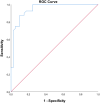Analysis of MMP-8, MMP-20, and TGF-β1 in molar-incisor hypomineralization and assessment of periodontal health
- PMID: 40676550
- PMCID: PMC12273313
- DOI: 10.1186/s12903-025-06551-9
Analysis of MMP-8, MMP-20, and TGF-β1 in molar-incisor hypomineralization and assessment of periodontal health
Abstract
Background: Gingival crevicular fluid (GCF) volume can be used to evaluate periodontal diseases, along with matrix metalloproteinase-8 (MMP-8) and transforming growth factor-beta 1 (TGF-β1) found in GCF. Conversely, matrix metalloproteinase-20 (MMP-20) is implicated in amelogenesis and serves as a potential biomarker for assessing enamel mineralization. In this context, the present study aims to investigate the effect of molar incisor hypomineralization (MIH) on periodontal health and to evaluate the relationship between MIH and GCF volume, as well as GCF biomarkers such as MMP-8, MMP-20, and TGF-β1.
Methods: The study was conducted on a total of 40 pediatric patients diagnosed with MIH (Study Group/SG), and 40 pediatric patients healthy for MIH (Control Group/CG). Clinical periodontal measurements (plaque index (PI), gingival index (GI), probing pocket depth (PPD), and GCF volume were performed. Concentrations of MMP-8, MMP-20, and TGF-β1 in GCF were determined using the enzyme-linked immunosorbent assay (ELISA). Mann-Whitney U test and T-test were used for statistical comparisons between groups. Binary Logistic Regression Analysis was performed for independent risk factors affecting MIH status. Finally, the ROC curve was used to determine the optimal cut-off value for MMP-20.
Results: PI, GI, PPD, and GCF volume values were significantly higher in the SG than in CG (p < 0.001, p = 0.007, p = 0.001, p = 0.007, respectively). According to binary logistic regression analysis, a one-unit decrease in MMP-20 level increased the risk of MIH four-fold (p < 0.001). However, no significant differences between the groups in terms of MMP-8 and TGF-β1 were observed (p = 0.564, p = 0.088, respectively). Finally, a significant area under the curve (AUC) value was found in determining MIH status for the MMP-20 variable (AUC = 0.948; p < 0.001).
Conclusions: Along with the increased tendency for gingivitis in MIH, detecting low concentrations of MMP-20, one of the biomarkers known to be effective in enamel mineralization, in the GCF of patients with MIH is the first information to record in the dental literature.
Trial registration: The trial protocol was retrospectively registered under ID NCT06764043 ( https://clinicaltrials.gov/ ); Jan 7, 2025.
Keywords: Gingival crevicular fluid; Matrix metalloproteinase 20; Matrix metalloproteinase 8; Molar incisor hypomineralization; Periodontal diseases; Transforming growth factor beta.
© 2025. The Author(s).
Conflict of interest statement
Declarations. Ethics approval and consent to participate: Ethical approval was obtained from the Non-Invasive Clinical Research Ethics Committee of Recep Tayyip Erdoğan University (Decision no: 2023/121). The study was conducted in accordance with the Declaration of Helsinki of 1975, as revised in 2013. The purpose and content of the research were explained to all individuals included in the study and voluntary consent forms were signed. Consent for publication: Not applicable. Competing interests: The authors declare no competing interests.
Figures



Similar articles
-
Serum vitamin D concentration is inversely associated with matrix metalloproteinase-9 level in periodontal diseases.J Periodontol. 2025 Jun;96(6):663-674. doi: 10.1002/JPER.24-0106. Epub 2024 Sep 23. J Periodontol. 2025. PMID: 39311712 Free PMC article.
-
The Desensitizing Effect of Nanosilver Fluoride Compared to Photobiomodulation Therapy in Molar-Incisor Hypomineralization: A Randomized Clinical Trial.J Evid Based Dent Pract. 2025 Sep;25(3):102139. doi: 10.1016/j.jebdp.2025.102139. Epub 2025 Mar 14. J Evid Based Dent Pract. 2025. PMID: 40716831 Clinical Trial.
-
Assessment of oral health-related quality of life (OHRQoL) in children with molar incisor hypomineralization (MIH) - A systematic review and meta-analysis of observational studies.J Indian Soc Pedod Prev Dent. 2022 Oct-Dec;40(4):368-376. doi: 10.4103/jisppd.jisppd_27_23. J Indian Soc Pedod Prev Dent. 2022. PMID: 36861552
-
Chlorhexidine mouthrinse as an adjunctive treatment for gingival health.Cochrane Database Syst Rev. 2017 Mar 31;3(3):CD008676. doi: 10.1002/14651858.CD008676.pub2. Cochrane Database Syst Rev. 2017. PMID: 28362061 Free PMC article.
-
Effect of photobiomodulation on the efficacy of anesthesia in maxillary permanent molar teeth with molar incisor hypomineralization: A randomized clinical trial.Int J Paediatr Dent. 2024 May;34(3):219-228. doi: 10.1111/ipd.13118. Epub 2023 Sep 8. Int J Paediatr Dent. 2024. PMID: 37688333 Clinical Trial.
References
-
- Lygidakis NA, Garot E, Somani C, Taylor GD, Rouas P, Wong FSL. Best clinical practice guidance for clinicians dealing with children presenting with molar-incisor-hypomineralisation (MIH): an updated European academy of paediatric dentistry policy document. Eur Arch Paediatr Dent. 2022;23:3–21. 10.1007/s40368-021-00668-5. - PMC - PubMed
-
- Turkmen E, Ozukoc C. Impact of molar incisor hypomineralization on oral hygiene and gingival health in 8–15-years-old children. Aust Dent J. 2022;67:50–6. 10.1111/adj.12923. - PubMed
-
- Alfano MC. The origin of gingival fluid. J Theor Biol. 1974;47:127–36. 10.1016/0022-5193(74)90103-9. - PubMed
-
- Chapple IL. Periodontal diagnosis and treatment–where does the future lie? Periodontol. 2000;2009(51):9–24. 10.1111/j.1600-0757.2009.00319.x. - PubMed
-
- Baker AH, Edwards DR, Murphy G. Metalloproteinase inhibitors: biological actions and therapeutic opportunities. J Cell Sci. 2002;115:3719–27. 10.1242/jcs.00063. - PubMed
Publication types
MeSH terms
Substances
Associated data
Grants and funding
- 1495/Recep Tayyip Erdogan University, Department of Scientific Research Project
- 1495/Recep Tayyip Erdogan University, Department of Scientific Research Project
- 1495/Recep Tayyip Erdogan University, Department of Scientific Research Project
- 1495/Recep Tayyip Erdogan University, Department of Scientific Research Project
- 02025002007284/Recep Tayyip Erdoğan University Development Foundation
LinkOut - more resources
Full Text Sources
Medical
Research Materials
Miscellaneous

